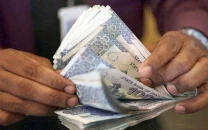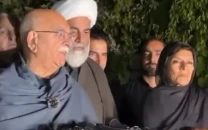This way, or that?: Taking it to the buyers
Govt is undecided on which privatisation route to take.

Govt is undecided on which privatisation route to take. ILLUSTRATION: JAMAL KHURSHID
With just over half a dozen entities shortlisted for the first phase of privatisation, the government now teeters between two choices: the easy route, which is to focus on capital market transactions; and the difficult route, which is to privatise the giants – a move more controversial and politically tedious, but one that will provide long-term solutions.
The stage is set
During recent talks with the International Monetary Fund (IMF) that concluded on November 8, Pakistan informed the visiting delegation that it would first take action regarding eight entities out of approved 31 under the Pak-IMF privatisation plan.
According to sources, entities shortlisted for either off-loading their shares in capital markets or selling them off include blue-chip companies like Oil and Gas Development Company Limited (OGDCL), Pakistan Petroleum Limited (PPL), Habib Bank Limited (HBL) and United Bank Limited (UBL). Furthermore, in the power sector, Islamabad, Lahore and Hyderabad power distribution companies have been shortlisted, in addition to two power generation companies.
These choices in themselves indicate the government’s inclination to opt for the easy path and avoid any agitation from both inside and outside parliament.
With the focus on OGDCL, PPL, HBL and UBL, the government will get relatively immediate returns and not huge, controversial layoffs.
However, it must be kept in mind that the losses incurred by Pakistan International Airlines (PIA) and Pakistan Steel Mills (PSM) are equal to what the government hopes to earn by selling shares of the blue-chip OGDCL.
The great conundrum
The federal government has so far remained reluctant to take any major steps to privatise PSM and the PIA because of massive layoffs that would ensue, a fear that the Pakistan Peoples Party (PPP) repeatedly underscored.
According to inside sources, PPP regularised up to 5,000 of its workers in PIA during its five year tenure, and also called the shots in PSM, where a majority of the workers supported the party.
Incumbent Finance Minister Ishaq Dar, in his capacity as member of Senate Standing Committee on Finance, revealed in 2011 that the privatisation of the banks led to around 56,000 layoffs.
However, the proponents of the privatisation process argue that although the privatisation of financial and telecommunication sectors companies led to massive layoffs in short term, they are now creating jobs for thousands of young people.
During the talks, the IMF expressed concern that the government was not doing enough to halt the hemorrhage in the power sector, in PIA and in PSM.
Both PSM and the PIA are among the 31 entities that the Cabinet Committee on Privatisation approved to be taken to the buyers. No clear deadlines have been set.
Although plans have indeed been crafted on paper, PIA is sustaining a Rs3 billion a month loss, while PSM’s monthly losses are estimated at Rs2 billion. Both enterprises together amount for almost Rs60 billion in annual losses.
What happens next
As the government drags its feet, the IMF has imposed a new structural benchmark in the $6.7 billion programme, making it binding for Pakistan to hire a financial adviser regarding PIA by March. This point person will prepare a strategy to sell 26% of PIA shares.
Under the new arrangement, the government will sell shares to a strategic investor by the end of December 2014.
Published in The Express Tribune, November 17th, 2013.



















COMMENTS
Comments are moderated and generally will be posted if they are on-topic and not abusive.
For more information, please see our Comments FAQ